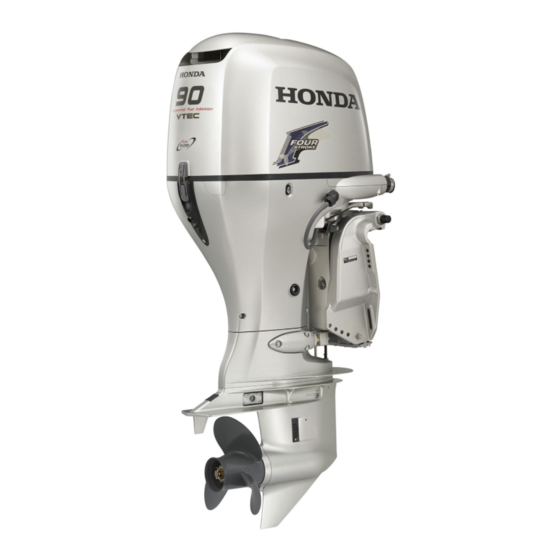
Table of Contents
Advertisement
Quick Links
Advertisement
Table of Contents

Summarization of Contents
Safety Information
Understanding Safety Symbols and Warnings
Explains safety alert symbols, hazard warnings, and operator responsibilities.
Fire, Burn, and Carbon Monoxide Hazards
Covers risks from gasoline, hot engine parts, and exhaust fumes.
Safety Label Locations
Identifying Safety Labels on Key Components
Shows locations of safety labels on the engine and fuel tank.
Component Identification
Type-Specific Component Identification
Details components for H, R, T, and G control types.
Common Component Identification
Identifies parts that are common across all models.
Controls and Features
H Type Controls Overview
Details tiller handle controls like ignition, shift lever, and throttle.
R Type Controls Overview
Explains remote control levers and functions for R1, R2, R3 types.
T Type Controls Overview
Covers power trim/tilt switches and manual relief valves.
G Type Controls Overview
Details tilt lever and transom angle adjustment.
Common Controls and Indicators
Explains shared controls, indicators, and warning systems.
Installation Procedures
Proper Transom Height and Mounting Location
Guides installation based on boat transom and mounting position.
Outboard Motor and Battery Installation
Details the physical motor mounting and battery connections.
Remote Control System and Propeller Setup
Covers remote control installation and propeller selection guidance.
Pre-Operation Checks
Engine Oil and Fuel System Checks
Procedures for checking engine oil level and fuel status.
Propeller, Tiller, and Battery System Checks
Inspecting propeller, tiller handle adjustments, and battery condition.
Other Essential Pre-Operation Checks
General checks for fuel hoses, stern brackets, and anodes.
Starting the Engine
Fuel Line Connection and Priming Procedure
Steps for connecting fuel lines and priming the fuel system.
Standard Engine Starting Procedures
Detailed starting sequences for H, R, R2, R3 control types.
Emergency Engine Starting Method
Procedure for starting the engine using the emergency starter rope.
Operation
New Engine Break-in Procedure
Recommended steps for breaking in a new outboard motor.
Gear Shifting and Steering Operation
How to change gears and steer the boat for different control types.
Cruising and Trim Angle Adjustments
Guidance on operating while cruising and adjusting trim angle.
Special Operating Modes and Features
Covers trolling control, tilting, moorage, and trim tabs.
Understanding Engine Protection Systems
Explains how warning systems alert the operator to potential issues.
Shallow Water and Multi-Motor Operation
Guidance for operating in shallow water and with multiple outboard motors.
Stopping the Engine
Emergency Engine Stop Procedure
Instructions for stopping the engine immediately in an emergency.
Normal Engine Stop Procedures
Standard steps for shutting down the engine.
Transporting and Trailering
Fuel Line Disconnection for Transport
Safety steps before transporting the motor.
Securing for Transport and Trailering
Methods for safely transporting and trailering the outboard motor.
Cleaning and Flushing
Routine Cleaning and Flushing Procedures
Steps for cleaning the outboard motor after use, especially in salt water.
Maintenance
Tools and Maintenance Schedule
Lists provided tools and the recommended service intervals.
Engine Oil and Spark Plug Maintenance
Procedures for checking and replacing engine oil and spark plugs.
Battery, Lubrication, and Water Separator Maintenance
Maintenance for battery, lubrication points, and water separator.
Fuel Filter, Fuse, and Propeller Maintenance
Procedures for maintaining fuel filters, fuses, and the propeller.
Post-Operation and Submerged Motor Checks
Checks after operation and procedures for submerged motors.
Storage Procedures
Fuel System Preparation for Storage
Steps to prepare the fuel system for long-term storage.
Battery and Motor Storage Guidelines
Proper methods for storing the battery and outboard motor.
Disposal
Environmentally Responsible Product Disposal
Guidance on proper disposal of the product, battery, and fluids.
Troubleshooting
Resolving Warning System Issues
Addresses common problems indicated by warning lights and buzzers.
Specifications
Model and General Specifications
Technical data for BF75D, BF80A, BF90D, BF100A models.
Noise and Vibration Specifications
Data on noise and vibration levels according to industry standards.











Need help?
Do you have a question about the BF80A and is the answer not in the manual?
Questions and answers